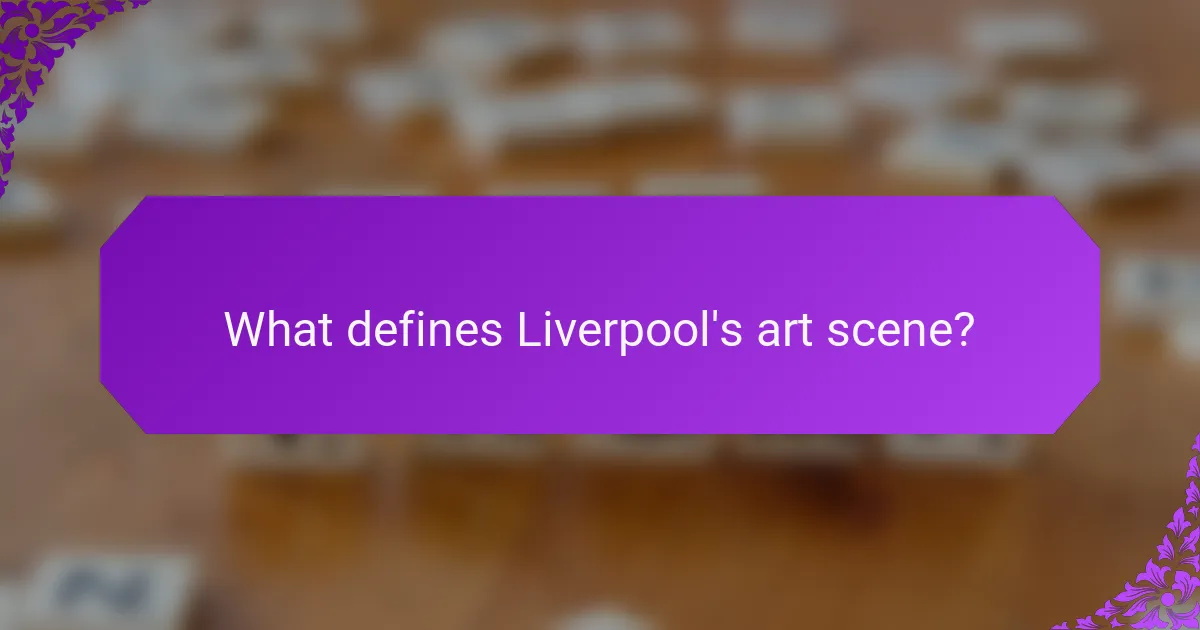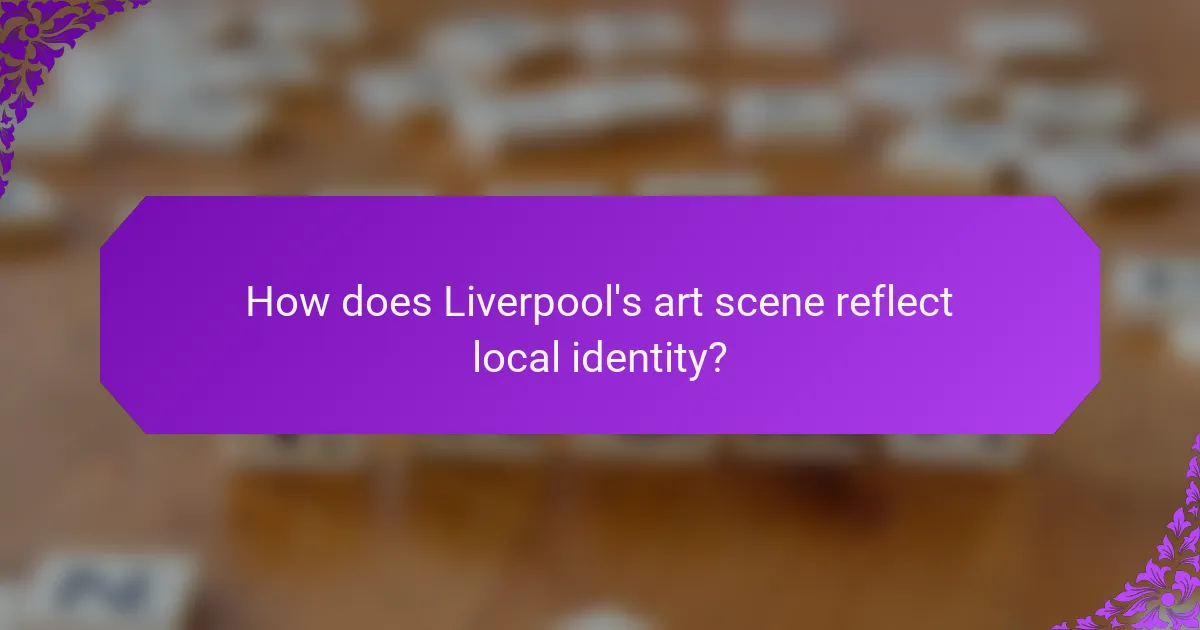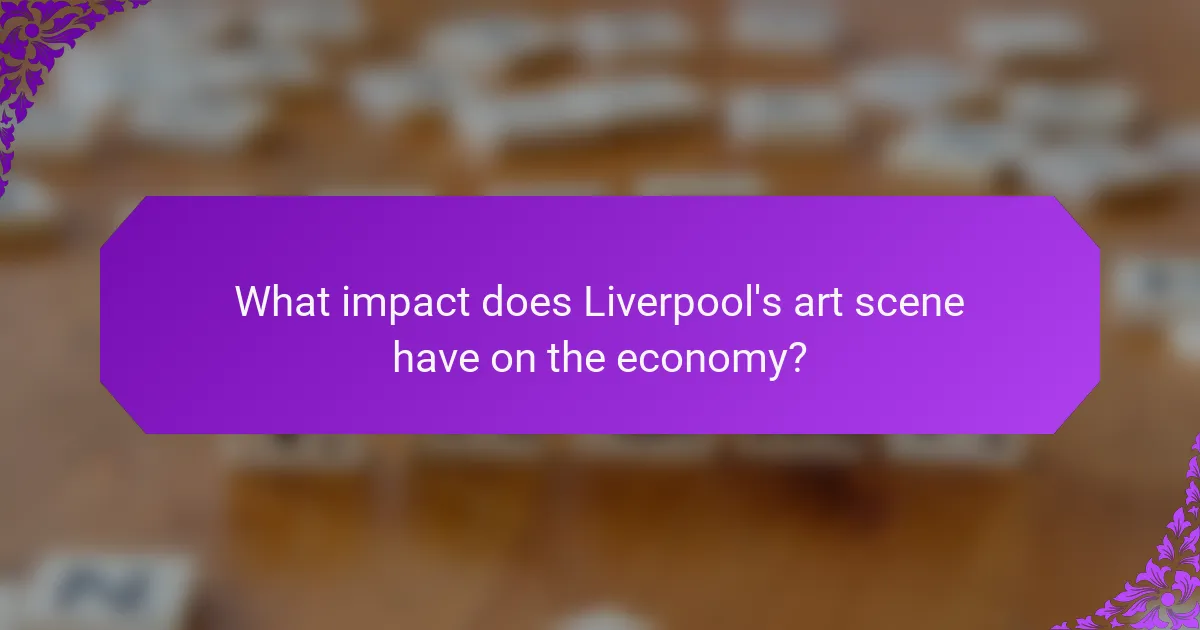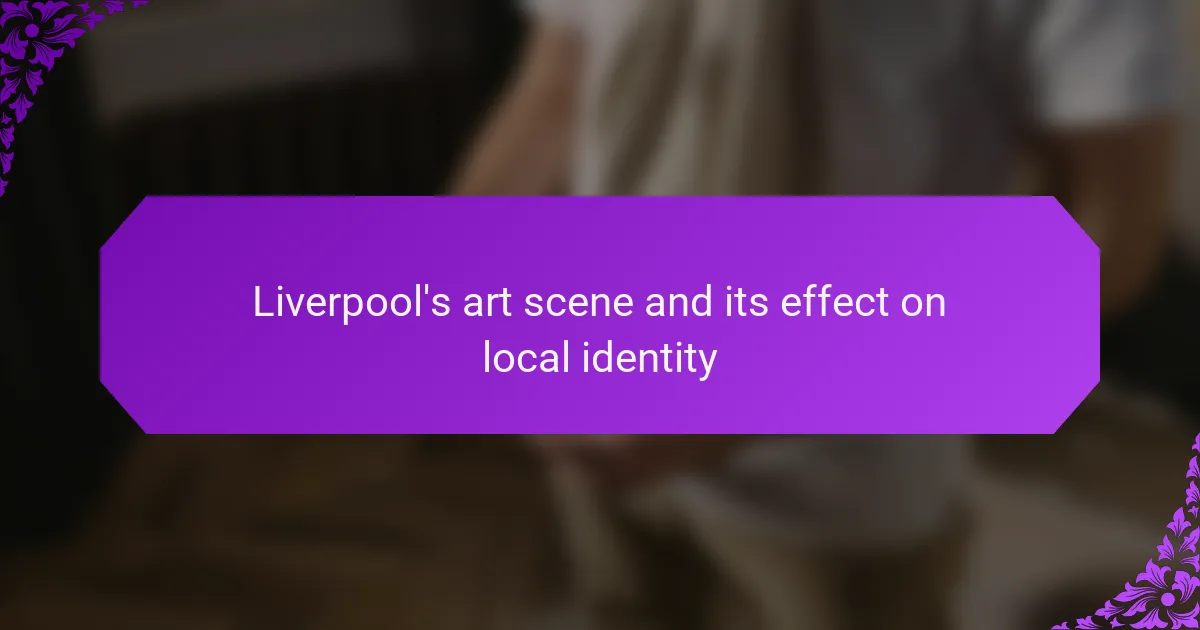Liverpool’s art scene is characterized by its cultural diversity, historical significance, and economic impact on the local community. The city is home to prominent galleries such as Tate Liverpool and the Walker Art Gallery, which feature both contemporary and classical artworks. Street art plays a vital role in reflecting local themes and social issues, while events like the Liverpool Biennial showcase contemporary artistic expressions. This vibrant art scene not only enhances Liverpool’s identity but also contributes over £200 million annually to the local economy through tourism, job creation, and community development.

What defines Liverpool’s art scene?
Liverpool’s art scene is defined by its vibrant cultural diversity and historical significance. The city hosts numerous galleries, such as the Tate Liverpool and the Walker Art Gallery. These institutions showcase both contemporary and classical art. Street art is also a prominent feature, with murals reflecting local themes and social issues. Additionally, Liverpool’s art scene is influenced by its musical heritage, particularly The Beatles. Events like the Liverpool Biennial highlight the city’s commitment to contemporary art. The city has a strong community of artists and creatives who contribute to its dynamic artistic landscape. This unique blend of history, community, and innovation shapes Liverpool’s identity as a cultural hub.
How has Liverpool’s art scene evolved over the years?
Liverpool’s art scene has evolved significantly over the years. Initially, it was heavily influenced by traditional maritime culture and industrial heritage. The establishment of institutions like the Walker Art Gallery in 1877 marked a shift towards more formal art appreciation. In the late 20th century, the rise of the Liverpool Biennial showcased contemporary art and attracted international attention. The city’s designation as a European Capital of Culture in 2008 further boosted its artistic reputation. Today, Liverpool features a diverse array of galleries, street art, and community projects. This evolution reflects the city’s broader cultural transformation and its ongoing commitment to artistic innovation.
What key movements have influenced Liverpool’s art scene?
Liverpool’s art scene has been influenced by several key movements. The Merseybeat movement in the 1960s brought a surge of creativity. This music scene inspired visual artists to explore new forms of expression. The Pop Art movement also had a significant impact. Artists like Peter Blake and Richard Hamilton emerged from this era. The 1980s saw the rise of the Liverpool Biennial. This event showcased contemporary art and attracted international attention. Additionally, the post-punk movement influenced a generation of artists. They incorporated social and political themes into their work. Urban art and street art have also shaped the scene in recent years. These movements reflect the city’s diverse culture and history.
How do local artists contribute to the evolution of this scene?
Local artists drive the evolution of Liverpool’s art scene through innovative expressions and community engagement. They introduce fresh perspectives that reflect the city’s unique culture. Collaborations among artists foster a vibrant exchange of ideas. Local exhibitions showcase emerging talent and attract diverse audiences. This engagement strengthens community ties and fosters a sense of belonging. Artists often draw inspiration from Liverpool’s history and social issues, adding depth to their work. Their contributions help shape the city’s identity and promote cultural tourism. Over time, local artists have transformed Liverpool into a recognized hub for contemporary art.
What role does public art play in Liverpool?
Public art in Liverpool serves as a vital expression of the city’s culture and identity. It enhances public spaces and fosters community engagement. Notable examples include the iconic Superlambanana and the Liverpool Biennial, which attract both locals and tourists. Public art initiatives often reflect the city’s history and social issues. They contribute to urban regeneration and economic development. A 2019 report highlighted that public art boosts local pride and cohesion. Additionally, it provides platforms for local artists to showcase their work. Overall, public art plays a crucial role in shaping Liverpool’s unique cultural landscape.
Why is public art significant to local identity in Liverpool?
Public art is significant to local identity in Liverpool because it reflects the city’s history and culture. The artworks often depict local stories and figures, fostering a sense of community pride. For instance, the iconic Superlambanana represents Liverpool’s maritime heritage and creativity. Public art also serves as a platform for social and political expression, engaging residents in important conversations. Events like the Liverpool Biennial showcase diverse artistic voices, reinforcing the city’s identity as a cultural hub. Additionally, public art enhances urban spaces, making them more inviting and accessible. This accessibility encourages interaction among residents and visitors, strengthening communal ties. Overall, public art in Liverpool plays a crucial role in shaping and expressing local identity.
What are some notable public art installations in the city?
Notable public art installations in Liverpool include “The Beatles Story” and “Superlambanana.” “The Beatles Story” celebrates the city’s iconic band with immersive exhibits. “Superlambanana” is a large sculpture combining a lamb and a banana, symbolizing Liverpool’s cultural identity. Another installation is “The Liver Birds,” which represents the city’s maritime heritage. These installations enhance local identity and attract tourism. They reflect Liverpool’s rich history and artistic expression.

How does Liverpool’s art scene reflect local identity?
Liverpool’s art scene reflects local identity through its diverse expressions of culture and history. The city’s rich maritime heritage inspires many artworks. Artists often draw on themes of community and social issues. Public murals and installations celebrate local figures and events. The annual Liverpool Biennial showcases contemporary art that engages with local narratives. Galleries like Tate Liverpool emphasize regional artists and their perspectives. The integration of music and performance art highlights Liverpool’s vibrant cultural scene. Overall, the art scene serves as a mirror, showcasing the unique identity of Liverpool and its residents.
In what ways does art express the cultural heritage of Liverpool?
Art expresses the cultural heritage of Liverpool through various forms, including visual arts, music, and performance. The city’s rich maritime history is depicted in public murals and sculptures. Notable artists like Peter Blake and the Liverpool Biennial showcase local talent and themes. Music, especially The Beatles’ legacy, reflects Liverpool’s identity and influences global culture. Festivals celebrate diverse communities and traditions, fostering unity. Galleries such as Tate Liverpool exhibit works that highlight regional narratives. Street art captures contemporary social issues while honoring historical events. These artistic expressions collectively reinforce Liverpool’s unique cultural narrative and identity.
How do artistic themes relate to the history of Liverpool?
Artistic themes reflect Liverpool’s rich history through cultural, social, and economic lenses. The city’s maritime heritage inspired themes of exploration and industry in various art forms. Liverpool’s role in the music scene, particularly with The Beatles, highlights themes of youth culture and innovation. Additionally, the impact of the Industrial Revolution is evident in visual arts, showcasing labor and urban life. The city’s diverse communities contribute to themes of identity and resilience in contemporary art. Events like the Liverpool Biennial further illustrate how artistic expressions connect to historical narratives. Overall, artistic themes serve as a mirror to Liverpool’s evolving identity throughout its history.
What stories do local artists tell through their work?
Local artists in Liverpool tell stories of community, culture, and heritage through their work. Their art reflects the city’s rich history and diverse population. Many pieces capture the struggles and triumphs of local life. Artists often draw inspiration from Liverpool’s maritime past and musical legacy. They explore themes of identity, belonging, and social issues. Public murals and installations frequently engage with the community’s collective memory. These artworks serve as a dialogue between the past and present. Through their creativity, local artists foster a sense of pride and connection among residents.
How does the art scene foster community engagement?
The art scene fosters community engagement by providing platforms for local artists and residents to connect. Art events, galleries, and public installations create spaces for interaction. These venues often host workshops and collaborative projects, encouraging participation. Community art initiatives promote inclusivity and cultural expression. Research shows that neighborhoods with active art scenes report higher social cohesion. For example, Liverpool’s Biennial attracts diverse audiences, fostering dialogue and collaboration. Engaging with art enhances local identity and pride among residents. This collective experience strengthens community bonds and encourages civic participation.
What initiatives promote collaboration between artists and the community?
Initiatives that promote collaboration between artists and the community include public art projects, community workshops, and artist residencies. Public art projects, such as murals and installations, engage residents and reflect local culture. Community workshops allow artists to share skills and create art with local participants. Artist residencies often encourage collaboration by immersing artists in community settings. Programs like Liverpool’s “Art in the Community” foster partnerships between artists and local organizations. These initiatives enhance community identity and strengthen social ties through creative expression.
How do local art events contribute to community identity?
Local art events significantly contribute to community identity by fostering social connections and cultural expression. They create a platform for local artists to showcase their work. This visibility helps cultivate pride in local talent and heritage. Additionally, art events often reflect the community’s history and values. They encourage participation from diverse groups, promoting inclusivity. Research indicates that communities with vibrant art scenes report higher levels of civic engagement. For example, the Liverpool Biennial attracts thousands, enhancing local culture and tourism. Overall, local art events serve as a vital link between residents and their cultural identity.

What impact does Liverpool’s art scene have on the economy?
Liverpool’s art scene significantly boosts the local economy. It attracts tourism and enhances cultural engagement. The creative industries contribute over £200 million annually to the city’s economy. Art events and festivals generate substantial visitor spending. Local artists and galleries create jobs and stimulate business growth. The investment in public art improves urban spaces, attracting further investment. Overall, the art scene fosters economic resilience and community development.
How does the art scene contribute to local tourism?
The art scene significantly contributes to local tourism by attracting visitors to cultural events and exhibitions. Art galleries and museums in Liverpool, such as Tate Liverpool, draw thousands of tourists annually. Cultural festivals, including the Liverpool Biennial, showcase contemporary art and engage diverse audiences. Local artists often collaborate with businesses, enhancing the appeal of the area. The vibrant street art scene offers unique photo opportunities, encouraging social media sharing. Art-related tours provide insights into the local culture, enriching the visitor experience. According to a report by the Arts Council England, cultural tourism generates substantial revenue for local economies. This underscores the essential role of the art scene in boosting Liverpool’s tourism industry.
What economic benefits arise from art-related events in Liverpool?
Art-related events in Liverpool generate significant economic benefits. These events attract tourists, boosting local businesses. For example, the Liverpool Biennial draws over 600,000 visitors, contributing millions to the local economy. Additionally, art events create jobs in various sectors, including hospitality and retail. They also encourage investment in infrastructure and public spaces. The cultural vibrancy enhances Liverpool’s appeal as a destination. Local artists gain exposure and opportunities, fostering creative industries. Overall, art-related events play a vital role in Liverpool’s economic landscape.
How do local businesses support the art community?
Local businesses support the art community by providing funding, resources, and venues for artists. They often sponsor art events and exhibitions, which helps to increase visibility for local artists. Many businesses display local artwork in their establishments, creating a platform for artists to showcase their work. Additionally, local businesses may collaborate with artists for special projects, enhancing community engagement. This support contributes to the vibrancy of Liverpool’s art scene and fosters a sense of local identity. Research indicates that communities with strong local business support for the arts experience higher levels of cultural engagement and economic growth.
What challenges does Liverpool’s art scene face?
Liverpool’s art scene faces several challenges. Funding cuts have significantly impacted local galleries and artists. The decline in public investment has led to reduced exhibition opportunities. Gentrification in certain areas has pushed out independent art spaces. Competition from larger cities can overshadow local talent. Limited access to affordable studio spaces hinders emerging artists. The COVID-19 pandemic further strained the art community, affecting events and sales. These factors collectively threaten the vibrancy and sustainability of Liverpool’s artistic landscape.
How do funding and resources affect local artists?
Funding and resources significantly impact local artists by providing essential support for their creative endeavors. Access to financial backing allows artists to purchase materials and tools needed for their work. It also enables them to invest in marketing and promotion to reach wider audiences. Additionally, funding can facilitate participation in exhibitions and art fairs, enhancing visibility. Resources such as grants and community programs can foster collaboration among artists, enriching the local art scene. Research indicates that areas with robust funding for the arts see increased cultural engagement and community pride. According to a study by the National Endowment for the Arts, communities with higher arts funding report greater economic growth and social cohesion. Thus, funding and resources are crucial for the sustainability and development of local artists.
What barriers exist for emerging artists in Liverpool?
Emerging artists in Liverpool face several barriers. Limited access to funding hampers their ability to create and promote their work. High rental costs for studio spaces make it difficult to establish a base. There is also a lack of visibility in mainstream galleries for new talent. Networking opportunities are often inaccessible to those without established connections. Additionally, competition from more established artists creates a challenging environment. These barriers collectively hinder the growth and recognition of emerging artists in the city.
What can individuals do to support Liverpool’s art scene?
Individuals can support Liverpool’s art scene by attending local exhibitions and performances. This participation boosts visibility for artists and venues. Purchasing artwork directly from local artists helps sustain their livelihoods. Volunteering at art organizations or events can provide essential support and resources. Sharing events on social media raises awareness and encourages attendance. Joining local art groups fosters community engagement and collaboration. Supporting local art businesses, such as galleries and studios, contributes to the local economy. Engaging in discussions about art in local forums enhances appreciation and understanding of the art scene.
How can residents get involved in local art initiatives?
Residents can get involved in local art initiatives by participating in community art projects. Many local organizations host workshops and events that welcome public participation. Residents can volunteer their time to assist artists or help organize events. Joining local art groups or societies is another way to engage with the art community. These groups often seek members for various initiatives and projects. Attending gallery openings and exhibitions also provides opportunities to connect with artists and fellow art enthusiasts. Additionally, residents can support local artists by purchasing their work or promoting their events on social media. Engaging with local schools and educational programs can foster collaboration with young artists. Overall, active participation strengthens the community’s art scene and enhances local identity.
What are some ways to promote and celebrate local artists?
Hosting art exhibitions showcases local artists’ work to the community. These events provide visibility and foster appreciation for local talent. Organizing art fairs allows artists to sell their creations directly to the public. This boosts their income and connects them with potential buyers. Collaborating with local businesses can create opportunities for artists to display their work in shops and cafes. This increases foot traffic and promotes community engagement. Social media campaigns can highlight local artists and their projects. Platforms like Instagram and Facebook reach wider audiences and generate interest. Creating artist spotlights on community websites or newsletters informs residents about local talent. This builds a sense of pride and connection within the community.
Liverpool’s art scene is a dynamic entity characterized by its cultural diversity and historical significance, featuring institutions like Tate Liverpool and the Walker Art Gallery, as well as vibrant street art. The evolution of this scene reflects the city’s maritime heritage and musical legacy, particularly influenced by movements such as Merseybeat and Pop Art. Local artists play a crucial role in shaping the community’s identity through public art initiatives and collaborative projects, while events like the Liverpool Biennial enhance cultural engagement and tourism. The art scene not only contributes to local identity but also significantly impacts the economy, despite facing challenges such as funding cuts and limited resources for emerging artists.
